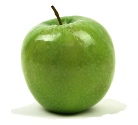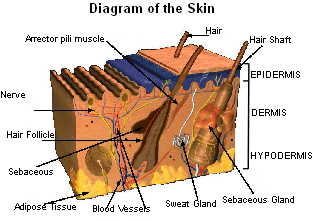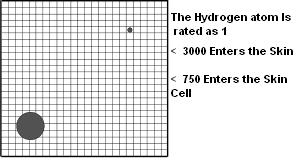



Helping you make healthy choices for you and your family

You may be wondering how certain chemicals from toiletries applied to the skin, hair and teeth are able to find their way into the body where they have the potential to cause long term damage to health. Hopefully, this mini biology lesson will help you to understand the basics.
So, how do these chemicals get into the body?
Surprisingly, they are able to pass into the body through our skin.
The skin is the body's largest organ accounting for 16% of body weight. It is comprised of 3 layers – Epidermis, Dermis, and Hypodermis.
Epidermis – is where skin cells are produced. The new ones form at the base and gradually push the older ones upwards where they become drier and flatter as they near the surface. At the base, the cells consist of 75% water which reduces to 1% at the surface where they shed.
Dermis – consists of:
Hair follicles where each hair forms.
Sebaceous glands which secrete oil to prevent dryness.
Sweat glands which secrete water and salts and help to keep the skin cool through evaporation of sweat on the skin surface.
Arrector Pili muscles which draw up the skin surface when we feel cold (goose pimples), making the surface area smaller to conserve body heat.
Blood vessels which help to nourish the skin and transport substances of a low molecular weight to the rest of the body.
Nerve Fibres which provide the sense of touch
Hypodermis – which is a layer of adipose (fatty) tissue.
Hair follicles where each hair forms.
Sebaceous glands which secrete oil to prevent dryness.
Sweat glands which secrete water and salts and help to keep the skin cool through evaporation of sweat on the skin surface.
Arrector Pili muscles which draw up the skin surface when we feel cold (goose pimples), making the surface area smaller to conserve body heat.
Blood vessels which help to nourish the skin and transport substances of a low molecular weight to the rest of the body.
Nerve Fibres which provide the sense of touch
Hypodermis – which is a layer of adipose (fatty) tissue.
Molecular Weights
Until quite recently, scientists believed the skin was a total barrier. They now know that it allows substances of a low molecular weight through.
If you think of the skin as a mesh like a tennis racquet, as in the diagram opposite, you will see how some molecules can pass through and others cannot.
If you think of the skin as a mesh like a tennis racquet, as in the diagram opposite, you will see how some molecules can pass through and others cannot.
Scientists have graded the Hydrogen atom as 1 for molecular weight and have discovered that any molecule below 3000 can enter the skin, below 750 can enter the skin cell, and below 150 can enter into the bloodstream. This discovery is being used increasingly with the introduction of transdermal patches like Nicotine, HRT and pain relief. They are popular because entry through the skin bypasses the stomach where many drugs can be altered by the stomach acid.
Sodium Lauryl Sulphate (SLS), commonly found in shampoos, shower gels, bubble bath liquids and toothpaste has a molecular weight of 288.38 which can easily pass into the cells. In studies, it has been found lodged in the heart, lungs, liver and brain up to five days after initial exposure. Seeing as we have multiple exposures a day, SLS accumulates and is constantly present until we stop using products containing it. In fact, SLS is often added to medicines to transport the active ingredients into the body. SLS is just one chemical and is by no means the only one from toiletries and cosmetics to pass into the body.
Sodium Lauryl Sulphate (SLS), commonly found in shampoos, shower gels, bubble bath liquids and toothpaste has a molecular weight of 288.38 which can easily pass into the cells. In studies, it has been found lodged in the heart, lungs, liver and brain up to five days after initial exposure. Seeing as we have multiple exposures a day, SLS accumulates and is constantly present until we stop using products containing it. In fact, SLS is often added to medicines to transport the active ingredients into the body. SLS is just one chemical and is by no means the only one from toiletries and cosmetics to pass into the body.
To read about some of the common questionable ingredients added to products we use regularly, click here.


Skin Absorption
| Your Health Your Future |
| Controversial Ingredients |
| Nutritional State |
| Parent and Child |
| Microwave Ovens |
| Recommended Books |
| Skin Absorption |
| Sodium Lauryl Sulphate |
| Propylene Glycol |
| DEA, MEA, TEA |
| Chemical Calculator |
| Fluoride |
| Aspartame |
| Fluoridation |
| Water Filtration |
| Planning a Pregnancy |
| Pregnancy Care |
| Post Pregnancy Care |
| Amazon Books |
| EBooks |
| About Us |
| Health Services |
